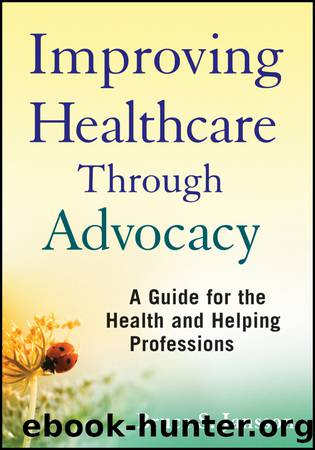Improving Healthcare Through Advocacy: A Guide for the Health and Helping Professions by Jansson Bruce S.;

Author:Jansson, Bruce S.; [Jansson, Bruce S.]
Language: eng
Format: epub
Publisher: John Wiley & Sons, Incorporated
Published: 2010-12-16T00:00:00+00:00
Scenario 8.7: Advocacy to Help Consumers Stop Smoking
Smoking contributes to the morbidity and lowered life expectancy more than any other lifestyle factor. It caused about 442,000 premature deaths each year from 1995 to 1999, including 264,000 men and 178,000 women (CDC, 2002a). While the incidence of smoking has decreased from 1965 to 2008 by 51%, it will continue to cause this health toll because of the time lag required to develop cancer and other illnesses from smoking and cumulative effect on specific personsâsave for those persons who stopped smoking five years ago who escape a considerable amount of their risk for many kinds of cancer, heart disease, and many other diseases (American Lung Association, 2010). Smoking is particularly prevalent among low-income persons and persons who did not complete high school.
Smoking can be viewed as a chronic disease with complex physiological and psychological componentsâwith less than 10% of smokers succeeding in quitting over the long term until recently (DHHS, 1990). Nicotine is highly addictiveâand smokers experience strong withdrawal symptoms when they stop smoking. Only 44% of smokers who had seen a physician in the previous year indicated in a Michigan survey they had ever been advised to quit smokingâand only 30% of young male smokers (Anda, Remington, Sienko, & Davis, 1987 ; Knight, 2004). The American Heart Association asks healthcare professionals to counsel smoking patients to quit at every office visit and to record how often they smoke with periodic updates. It suggests all clinicians receive training in patient-centered counseling techniques (Knight, 2004 ; Ockene & Houston, 1997). Relatively few hospitals have clinics to provide this therapy. A combination of counseling, monitoring, and pharmacotherapy are relatively effectiveâincluding use of nicotine patches and oral nicotine medications. Roughly 21% of persons who combine counseling with pharmacotherapy quit smoking for extended periods (Fellows, Bush, McAfee, & Dickerson, 2007).
Consumers need strategies not only for their own smoking, but how to avoid secondhand smoke, which has been implicated in causing cancer and other diseases.
Case advocates should ask consumers if their physicians have:
Discussed smoking with them.
Monitored their smoking at each appointment.
Identified places they can obtain help with ending smoking.
Discussed with them how medication and counseling, together, have greater success than either of them alone.
Asked them if they are exposed to secondhand smoke in their homes or places of workâand how they might reduce this risk.
Download
This site does not store any files on its server. We only index and link to content provided by other sites. Please contact the content providers to delete copyright contents if any and email us, we'll remove relevant links or contents immediately.
The Secret History by Donna Tartt(16662)
The Social Justice Warrior Handbook by Lisa De Pasquale(11494)
Thirteen Reasons Why by Jay Asher(7803)
This Is How You Lose Her by Junot Diaz(5800)
Weapons of Math Destruction by Cathy O'Neil(5046)
Zero to One by Peter Thiel(4835)
The Myth of the Strong Leader by Archie Brown(4796)
Promise Me, Dad by Joe Biden(4456)
Beartown by Fredrik Backman(4434)
Stone's Rules by Roger Stone(4423)
How Democracies Die by Steven Levitsky & Daniel Ziblatt(4414)
The Fire Next Time by James Baldwin(4351)
100 Deadly Skills by Clint Emerson(4086)
A Higher Loyalty: Truth, Lies, and Leadership by James Comey(4041)
Rise and Kill First by Ronen Bergman(4021)
The David Icke Guide to the Global Conspiracy (and how to end it) by David Icke(3892)
The Farm by Tom Rob Smith(3878)
Secrecy World by Jake Bernstein(3789)
The Doomsday Machine by Daniel Ellsberg(3737)
